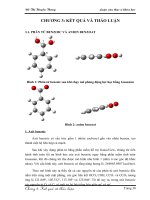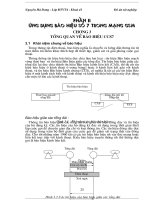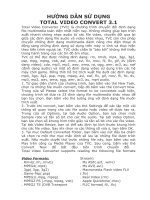3 1 rock cycle
Bạn đang xem bản rút gọn của tài liệu. Xem và tải ngay bản đầy đủ của tài liệu tại đây (653.94 KB, 16 trang )
Starter
1. What charges do protons, neutrons, and
electrons have?
2. Minerals that form from magma form as the
result of _______________________.
3. Why is color not a useful identification property?
4. What is a mineral’s streak?
5. What is the most common mineral group?
Starter
1. Recent global warming appears to be the result of
a.
b.
c.
d.
Changes in global wind patterns
A decrease in the greenhouse effect
Increases in greenhouse gases in the air
Changes in Earth’s revolution around the sun
2. Melting ice caps result in which of the following?
a.
b.
c.
d.
A rise in sea level
A fall in sea level
Colder temperatures
Less precipitation
3. In a dry climate, yearly precipitation is
a.
b.
c.
d.
Less than the rate of evaporation
Greater than the rate of evaporation
Greater in a desert than in a steppe
Less than in a polar climate
3.1 The Rock Cycle P.64
/>
Today, you will be able to:
• Define the term rock.
•Identify the three major types of rocks and explain how
they differ.
•Describe the rock cycle.
•List the forces that power Earth’s rock cycle.
Vocabulary
•
•
•
•
•
•
•
•
•
Rock
Igneous rock
Sedimentary rock
Metamorphic rock
Rock cycle
Magma
Lava
Weathering
Sediments
Rocks
•
•
•
•
Rocks contain clues about the environments in
which they were formed.
For example, rocks with shell fragments were
probably formed near the ocean and volcanic
rocks give clues to where volcanic activity has
occurred on Earth.
A rock is any solid mass of minerals or minerallike matter occurring naturally as part of Earth.
Most rocks are combinations of many minerals
and can be classified based on their composition
and texture.
•
•
Rocks
Rocks are generally grouped into one of three
groups based on how they formed. These three
groups are igneous, metamorphic, and
sedimentary.
All three groups interact with each other. The
process that shows how the groups interact is
called the rock cycle.
The Rock Cycle
•
•
•
Magma is melted
material beneath
Earth’s surface.
When it cools and
hardens (crystallizes)
below the surface or
during a volcanic
eruption, an igneous
rock is formed.
Magma that reaches
the surface is called
lava.
Igneous Rocks
Obsidian
/>urriculum/geology/images
/Obsidian1.jpg
Granite
/>/1/0/g/V/granitesalinia.jpg
Pumice
/>/1/0/L/W/pumiceoakland.j
The Rock Cycle
•
•
•
Any rock on the
surface will eventually
break down.
Weathering is a
process in which
rocks are physically
and chemically
broken down by
water, wind, and
living things.
Weathered pieces of
rock are called
The Rock Cycle
•
•
Sediments are moved
around Earth by
water, wind, gravity,
and other organisms.
Eventually, after
sediments are
deposited, they can
be compacted and
cemented together to
form a sedimentary
rock.
Sedimentary Rocks
Siltstone
/>/1/0/m/7/1/mckittrick9.jpg
u/vtgeographic/textbook/g
eology/Sedimentary_laye
rs.jpg
The Rock Cycle
•
•
Any rock that is
exposed to extreme
changes in heat and
pressure will undergo
a change.
This change results in
a metamorphic rock.
Metamorphic Rocks
Gneiss
Slate
/>/1/0/Y/S/1/rocpicgneiss.jp
g
/>/1/0/f/S/1/rocpicslate.jpg
The Rock Cycle
•
•
•
Where does the energy that drives Earth’s
rock cycle come from?
– Processes driven by heat from Earth’s
interior are responsible for forming igneous
and metamorphic rocks.
– Weathering and movement of sediments
are external processes powered by energy
from the sun.
Internal igneous, metamorphic
External sedimentary
The Rock Cycle (page 63)
Post-Test (page 42)
1. What is a rock?
2. What are the three major types of rocks?
3. How do igneous, sedimentary, and
metamorphic rocks differ?
4. What is the rock cycle?
5. What powers the Earth’s rock cycle?









